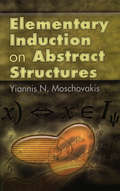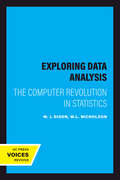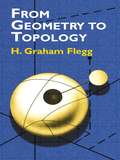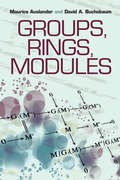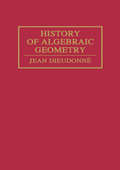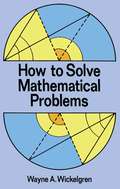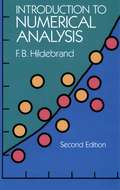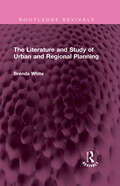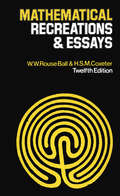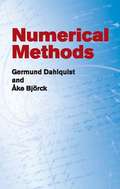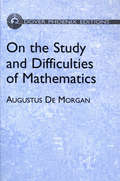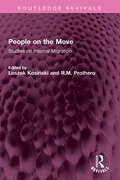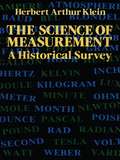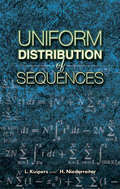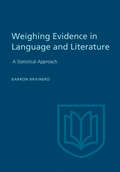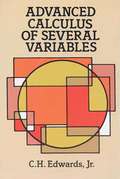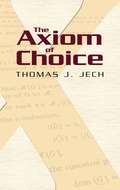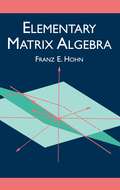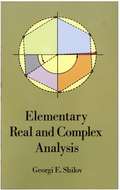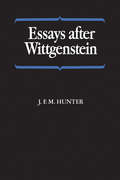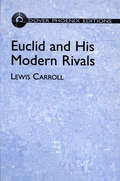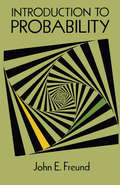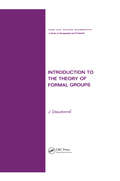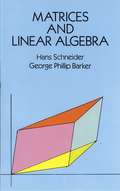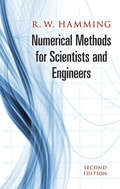- Table View
- List View
Elementary Induction on Abstract Structures
by Yiannis N. MoschovakisHailed by the Bulletin of the American Mathematical Society as "easy to use and a pleasure to read," this research monograph is recommended for students and professionals interested in model theory and definability theory. The sole prerequisite is a familiarity with the basics of logic, model theory, and set theory.The author, Professor of Mathematics at UCLA and Emeritus Professor of Mathematics,University of Athens, Greece, begins with a focus on the theory of inductive and hyperelementary sets. Subsequent chapters advance to acceptable structures and countable acceptable structures, concluding with the main result of the Barwise-Gandy-Moschovakis theory, which is the key to many applications of abstract recursion theory. Exercises at the end of each chapter form an integral part of the text, offering examples useful to the development of the general theory and outlining the theory's extensions.
Exploring Data Analysis: The Computer Revolution in Statistics
by W. J. Dixon W. L. Nicholson xxx National Bureau of StandardsThis title is part of UC Press's Voices Revived program, which commemorates University of California Press’s mission to seek out and cultivate the brightest minds and give them voice, reach, and impact. Drawing on a backlist dating to 1893, Voices Revived makes high-quality, peer-reviewed scholarship accessible once again using print-on-demand technology. This title was originally published in 1974.This title is part of UC Press's Voices Revived program, which commemorates University of California Press’s mission to seek out and cultivate the brightest minds and give them voice, reach, and impact. Drawing on a backlist dating to 1893, Voices Revived</DIV
From Geometry to Topology (Dover Books on Mathematics)
by H. Graham FleggThis excellent introduction to topology eases first-year math students and general readers into the subject by surveying its concepts in a descriptive and intuitive way, attempting to build a bridge from the familiar concepts of geometry to the formalized study of topology. The first three chapters focus on congruence classes defined by transformations in real Euclidean space. As the number of permitted transformations increases, these classes become larger, and their common topological properties become intuitively clear. Chapters 4-12 give a largely intuitive presentation of selected topics. In the remaining five chapters, the author moves to a more conventional presentation of continuity, sets, functions, metric spaces, and topological spaces. Exercises and Problems. 101 black-and-white illustrations. 1974 edition.
Groups, Rings, Modules (Dover Books on Mathematics)
by Maurice Auslander David BuchsbaumThis classic monograph is geared toward advanced undergraduates and graduate students. The treatment presupposes some familiarity with sets, groups, rings, and vector spaces. The four-part approach begins with examinations of sets and maps, monoids and groups, categories, and rings. The second part explores unique factorization domains, general module theory, semisimple rings and modules, and Artinian rings. Part three's topics include localization and tensor products, principal ideal domains, and applications of fundamental theorem. The fourth and final part covers algebraic field extensions and Dedekind domains. Exercises are provided at the end of each chapter.
History Algebraic Geometry
by Suzanne C. DieudonneThis book contains several fundamental ideas that are revived time after time in different guises, providing a better understanding of algebraic geometric phenomena. It shows how the field is enriched with loans from analysis and topology and from commutative algebra and homological algebra.
How to Solve Mathematical Problems
by Wayne A. WickelgrenIf you've ever tried to solve mathematical problems without any idea how to go about it, this book is for you. It will improve your ability to solve all kinds of mathematical problems whether in mathematics, science, engineering, business, or purely recreational mathematical problems (puzzles, games, etc.).In the pages of this book you'll discover seven indispensable problem-solving techniques: inference, classification of action sequences, state evaluation and hill climbing, subgoals, contradiction, working backward and relations between problems. Based on modern advances in the fields of artificial intelligence and computer simulation of thought, the techniques are taught here by an effective problem-solving methodology. Dr. Wickelgren, formerly a Professor of Psychology at MIT and the University of Oregon, first defines a problem-solving method, then illustrates its application to simple recreational mathematics problems that require no more background than a year of high school algebra and a year of plane geometry. By devoting the majority of the book to such "puzzle" problems, which require less background and information than more advanced mathematics and science problems, the author reaches the widest possible audience. In the final chapter, however, Dr. Wickelgren deals with specific problems from mathematics, science, and engineering. Throughout the book, sample problems illustrate each method and the author has supplied hints and complete solutions.Carefully and clearly written, this indispensable guide will help students in every discipline avoid countless hours of frustration and wasted effort. It is an ideal book for early undergraduate courses in mathematics, physical science, engineering, computer science, economics and other fields that require problem solving. Preface. Introduction. References.Index. 73 line illustrations.
Introduction to Numerical Analysis: Second Edition
by F. B. HildebrandThe ultimate aim of the field of numerical analysis is to provide convenient methods for obtaining useful solutions to mathematical problems and for extracting useful information from available solutions which are not expressed in tractable forms. This well-known, highly respected volume provides an introduction to the fundamental processes of numerical analysis, including substantial grounding in the basic operations of computation, approximation, interpolation, numerical differentiation and integration, and the numerical solution of equations, as well as in applications to such processes as the smoothing of data, the numerical summation of series, and the numerical solution of ordinary differential equations.Chapter headings include:l. Introduction2. Interpolation with Divided Differences3. Lagrangian Methods4. Finite-Difference Interpolation5. Operations with Finite Differences6. Numerical Solution of Differential Equations7. Least-Squares Polynomial ApproximationIn this revised and updated second edition, Professor Hildebrand (Emeritus, Mathematics, MIT) made a special effort to include more recent significant developments in the field, increasing the focus on concepts and procedures associated with computers. This new material includes discussions of machine errors and recursive calculation, increased emphasis on the midpoint rule and the consideration of Romberg integration and the classical Filon integration; a modified treatment of prediction-correction methods and the addition of Hamming's method, and numerous other important topics.In addition, reference lists have been expanded and updated, and more than 150 new problems have been added. Widely considered the classic book in the field, Hildebrand's Introduction to Numerical Analysis is aimed at advanced undergraduate and graduate students, or the general reader in search of a strong, clear introduction to the theory and analysis of numbers.
The Literature and Study of Urban and Regional Planning (Routledge Revivals)
by Brenda WhiteFirst published in 1974, The Literature and Study of Urban and Regional Planning discusses the processes of spatial planning and the range of subject knowledge which is required to contribute to it. It describes the physical forms in which the literature relating to spatial planning is usually presented and the ways in which this literature is made available in different types of organization. The author gives details of the most useful libraries whose facilities are available to students, and of the research which is being undertaken into the principal problems of planning information. The second part of the book consists of a subject bibliography, divided for ease of reference into twenty-six sections each concerned with a component part of spatial planning and containing annotated references to books, official publications, developmental plans, legislation, and other material. This book will be of interest to students of sociology and urban studies.
Mathmatical Recreations & Essays (12th Edition)
by H.S.M. Coxeter W. W. BallFor over eighty years this delightful classic has provided entertainment through mathematical problems commonly known as recreations. Although they often involve fundamental mathematical methods and notions, their chief appeal is as games or puzzles rather than the usefulness of their conclusions. This new edition upholds the original, but the terminology and treatment of problems have been updated and much new material has been added. There are new selections on polyominoes and the notion of dragon designs, and a new chapter, 'Introduction to Combinatorics.' Other topics dealt with in the fourteen chapters include arithmetical and geometrical recreations and problems, polyhedra, chess-board recreations, unicursal problems, cryptography and cryptanalysis, and calculating prodigies. Since no knowledge of calculus or analytic geometry is necessary to enjoy the recreations, this book will appeal widely to teachers of mathematics and students and to anyone who is mathematically inclined.
Numerical Methods (Dover Books on Mathematics)
by Germund Dahlquist Åke BjörckPractical text strikes fine balance between students' requirements for theoretical treatment and needs of practitioners, with best methods for large- and small-scale computing. Prerequisites are minimal (calculus, linear algebra, and preferably some acquaintance with computer programming). Text includes many worked examples, problems, and an extensive bibliography.
On the Study and Difficulties of Mathematics
by Augustus De MorganOne of the twentieth century's most eminent mathematical writers, Augustus De Morgan enriched his expositions with insights from history and psychology. On the Study and Difficulties of Mathematics represents some of his best work, containing points usually overlooked by elementary treatises, and written in a fresh and natural tone that provides a refreshing contrast to the mechanical character of common textbooks.Presuming only a knowledge of the rules of algebra and Euclidean theorems, De Morgan begins with some introductory remarks on the nature and objects of mathematics. He discusses the concept of arithmetical notion and its elementary rules, including arithmetical reactions and decimal fractions. Moving on to algebra, he reviews the elementary principles, examines equations of the first and second degree, and surveys roots and logarithms. De Morgan's book concludes with an exploration of geometrical reasoning that encompasses the formulation and use of axioms, the role of proportion, and the application of algebra to the measurement of lines, angles, the proportion of figures, and surfaces.
People on the Move: Studies on Internal Migration (Routledge Revivals)
by Leszek A. Kosinski R. Mansell ProtheroOriginally published in 1975, this volume examines conceptual and theoretical aspects of the study of internal migration, both in chapters dealing specifically with theory and data and in case studies. The book discusses the question of who migrates, and why and what are the patterns of flow and direction of movement. The consequences of migration are analysed. Migration is one of the most difficult components of population change to conceptualize and measure and this book considers a wide range of aspects of migration and the problems connected with it.
The Science of Measurement: A Historical Survey
by Herbert Arthur Klein"Klein is both a skilled reporter and a wide-ranging humanistic scholar. The book is popular and learned, witty and serious, literary and mathematical -- always solid and entertaining." -- Los Angeles Times.Although the topic of measurement might seem to lend itself to a dry-as-dust treatment, this book is just the opposite: an engrossing, easy-to-read study that treats a multifaceted topic with wit, imagination, and wide-ranging scholarship.Metrology, the science of measurement, usually concerns itself with length, weight, volume, temperature, and time, but in this comprehensive work the topic also encompasses nuclear radiation, thermal power, light, pressure, sound, and many other areas. Representing nearly ten years of research effort, The Science of Measurement is considered a definitive book on the concepts and units by which we measure everything in our universe. Nontechnical in its approach, it is not only completely accessible to the general reader but as entertaining and fun to read as it is informative and comprehensive. " . . . not concerned only with problems of measuring the limits of space or the size of the proton. It is filled with interesting digressions. Not a book for daydreaming, but a book for the curious. Klein's survey of the units and concepts by which we measure everything in the universe helps us understand that universe much better." -- Boston Herald Advertiser
Uniform Distribution of Sequences (Dover Books on Mathematics)
by L. Kuipers H. NiederreiterThe theory of uniform distribution began with Hermann Weyl's celebrated paper of 1916. In later decades, the theory moved beyond its roots in diophantine approximations to provide common ground for topics as diverse as number theory, probability theory, functional analysis, and topological algebra. This book summarizes the theory's development from its beginnings to the mid-1970s, with comprehensive coverage of both methods and their underlying principles.A practical introduction for students of number theory and analysis as well as a reference for researchers in the field, this book covers uniform distribution in compact spaces and in topological groups, in addition to examinations of sequences of integers and polynomials. Notes at the end of each section contain pertinent bibliographical references and a brief survey of additional results. Exercises range from simple applications of theorems to proofs of propositions that expand upon results stated in the text.
Weighting Evidence in Language and Literature
by Barron BrainerdIn recent years, there has been a tremendous development in the area of quantitative and statistical analysis of linguistic and literary data, generated, no doubt, by extensive advances in computer technology and their relatively easy availability to scholars. However, except for a few rather specialized examples, there has been no truly introductory text in statistics and quantitative analysis devoted to the needs of language scholars. This work was written especially to fill the gap. It introduces a mathematically naïve reader to those statistical tools which are applicable in modern quantitative text and language analysis, and does this in terms of simple examples dealing exclusively with language and literature. Exercises are included throughout.
Advanced Calculus of Several Variables (Dover Books on Mathematics)
by C. H. Edwards Jr.Modern conceptual treatment of multivariable calculus, emphasizing interplay of geometry and analysis via linear algebra and the approximation of nonlinear mappings by linear ones. Over 400 well-chosen problems. 1973 edition.
The Axiom of Choice
by Thomas J. JechComprehensive in its selection of topics and results, this self-contained text examines the relative strengths and consequences of the axiom of choice. Each chapter contains several problems, graded according to difficulty, and concludes with some historical remarks.An introduction to the use of the axiom of choice is followed by explorations of consistency, permutation models, and independence. Subsequent chapters examine embedding theorems, models with finite supports, weaker versions of the axiom, and nontransferable statements. The final sections consider mathematics without choice, cardinal numbers in set theory without choice, and properties that contradict the axiom of choice, including the axiom of determinacy and related topics
Elementary Matrix Algebra (Dover Books on Mathematics)
by Franz E. HohnThis complete and coherent exposition, complemented by numerous illustrative examples, offers readers a text that can teach by itself. Fully rigorous in its treatment, it offers a mathematically sound sequencing of topics. The work starts with the most basic laws of matrix algebra and progresses to the sweep-out process for obtaining the complete solution of any given system of linear equations -- homogeneous or nonhomogeneous -- and the role of matrix algebra in the presentation of useful geometric ideas, techniques, and terminology.Other subjects include the complete treatment of the structure of the solution space of a system of linear equations, the most commonly used properties of determinants, and linear operators and linear transformations of coordinates. Considerably more material than can be offered in a one-semester course appears here; this comprehensive volume by Franz E. Hohn, Professor of Mathematics at the University of Illinois for many years, provides instructors with a wide range of choices in order to meet differing interests and to accommodate students with varying backgrounds.
Elementary Real and Complex Analysis
by Georgi E. ShilovIn this book the renowned Russian mathematician Georgi E. Shilov brings his unique perspective to real and complex analysis, an area of perennial interest in mathematics. Although there are many books available on the topic, the present work is specially designed for undergraduates in mathematics, science and engineering. A high level of mathematical sophistication is not required.The book begins with a systematic study of real numbers, understood to be a set of objects satisfying certain definite axioms. The concepts of a mathematical structure and an isomorphism are introduced in Chapter 2, after a brief digression on set theory, and a proof of the uniqueness of the structure of real numbers is given as an illustration. Two other structures are then introduced, namely n-dimensional space and the field of complex numbers.After a detailed treatment of metric spaces in Chapter 3, a general theory of limits is developed in Chapter 4. Chapter 5 treats some theorems on continuous numerical functions on the real line, and then considers the use of functional equations to introduce the logarithm and the trigonometric functions. Chapter 6 is on infinite series, dealing not only with numerical series but also with series whose terms are vectors and functions (including power series). Chapters 7 and 8 treat differential calculus proper, with Taylor's series leading to a natural extension of real analysis into the complex domain. Chapter 9 presents the general theory of Riemann integration, together with a number of its applications. Analytic functions are covered in Chapter 10, while Chapter 11 is devoted to improper integrals, and makes full use of the technique of analytic functions.Each chapter includes a set of problems, with selected hints and answers at the end of the book. A wealth of examples and applications can be found throughout the text. Over 340 theorems are fully proved.
Essays after Wittgenstein
by J.F.M. HunterWritten within the tradition of Wittgenstein's work, these eight original essays in philosophical psychology are either by-products of efforts to understand Wittgenstein's later writings or applications of techniques and approaches derived from Wittgenstein to problems about which he did not say a great deal. In much of his later writings, Wittgenstein was not so much trying to explain his own views as to tease, annoy, and confuse the reader into working our for himself solutions to some philosophical problems. Professor Hunter, goaded and guided by Wittgenstein, here presents in clear and plain prose the views that he has worked out on a number of different questions. Although the essays are not exegetical in form, they will be found by students of the great philosopher to contain a large number of novel suggestions as to how Wittgenstein might be interpreted; philosophers, psychologists, linguists, and mathematicians are offered an unconventional, interesting, and richly argued approach to some of the main problems in philosophical psychology. The essays treat Meaning, Telling, Pain, Logical Compulsion, Identity, Imagining, Dreaming, and Talking. One eminent scholar has predicted that this volume may reverse the present tendency of philosophers to follow the lead of Noam Chomsky in the philosophy of language.
Euclid and His Modern Rivals (Dover Books on Mathematics)
by Lewis CarrollThe author of Alice in Wonderland (and an Oxford professor of mathematics) employs the fanciful format of a play set in Hell to take a hard look at late-19th-century interpretations of Euclidean geometry. Carroll's penetrating observations on geometry are accompanied by ample doses of his famous wit. 1885 edition.
Introduction to Probability
by John E. FreundThorough, lucid coverage of permutations and factorials, probabilities and odds, frequency interpretation, mathematical expectation, decision making, postulates of probability, rule of elimination, binomial distribution, geometric distribution, standard deviation, law of large numbers, and much more. Exercises with some solutions. Summary. Bibliography. Includes 42 black-and-white illustrations. 1973 edition.
Introduction to the Theory of Formal Groups
by Jean A. DieudonneThe concept of formal Lie group was derived in a natural way from classical Lie theory by S. Bochner in 1946, for fields of characteristic 0. Its study over fields of characteristic p > 0 began in the early 1950’s, when it was realized, through the work of Chevalley, that the familiar “dictionary” between Lie groups and Lie algebras completely broke down for Lie algebras of algebraic groups over such a field. This volume, starts with the concept of C-group for any category C (with products and final object), but the author’s do not exploit it in its full generality. The book is meant to be introductory to the theory, and therefore the necessary background to its minimum possible level is minimised: no algebraic geometry and very little commutative algebra is required in chapters I to III, and the algebraic geometry used in chapter IV is limited to the Serre- Chevalley type (varieties over an algebraically closed field).
Matrices and Linear Algebra (Dover Books on Mathematics)
by Hans Schneider George Phillip BarkerLinear algebra is one of the central disciplines in mathematics. A student of pure mathematics must know linear algebra if he is to continue with modern algebra or functional analysis. Much of the mathematics now taught to engineers and physicists requires it.This well-known and highly regarded text makes the subject accessible to undergraduates with little mathematical experience. Written mainly for students in physics, engineering, economics, and other fields outside mathematics, the book gives the theory of matrices and applications to systems of linear equations, as well as many related topics such as determinants, eigenvalues, and differential equations.Table of Contents:l. The Algebra of Matrices2. Linear Equations3. Vector Spaces4. Determinants5. Linear Transformations6. Eigenvalues and Eigenvectors7. Inner Product Spaces8. Applications to Differential EquationsFor the second edition, the authors added several exercises in each chapter and a brand new section in Chapter 7. The exercises, which are both true-false and multiple-choice, will enable the student to test his grasp of the definitions and theorems in the chapter. The new section in Chapter 7 illustrates the geometric content of Sylvester's Theorem by means of conic sections and quadric surfaces. 6 line drawings. lndex. Two prefaces. Answer section.
Numerical Methods for Scientists and Engineers (Dover Books on Mathematics)
by Richard HammingNumerical analysis is a subject of extreme interest to mathematicians and computer scientists, who will welcome this first inexpensive paperback edition of a groundbreaking classic text on the subject. In an introductory chapter on numerical methods and their relevance to computing, well-known mathematician Richard Hamming ("the Hamming code," "the Hamming distance," and "Hamming window," etc.), suggests that the purpose of computing is insight, not merely numbers. In that connection he outlines five main ideas that aim at producing meaningful numbers that will be read and used, but will also lead to greater understanding of how the choice of a particular formula or algorithm influences not only the computing but our understanding of the results obtained.The five main ideas involve (1) insuring that in computing there is an intimate connection between the source of the problem and the usability of the answers (2) avoiding isolated formulas and algorithms in favor of a systematic study of alternate ways of doing the problem (3) avoidance of roundoff (4) overcoming the problem of truncation error (5) insuring the stability of a feedback system.In this second edition, Professor Hamming (Naval Postgraduate School, Monterey, California) extensively rearranged, rewrote and enlarged the material. Moreover, this book is unique in its emphasis on the frequency approach and its use in the solution of problems. Contents include:I. Fundamentals and AlgorithmsII. Polynomial Approximation- Classical TheoryIll. Fourier Approximation- Modern TheoryIV. Exponential Approximation ... and moreHighly regarded by experts in the field, this is a book with unlimited applications for undergraduate and graduate students of mathematics, science and engineering. Professionals and researchers will find it a valuable reference they will turn to again and again.
